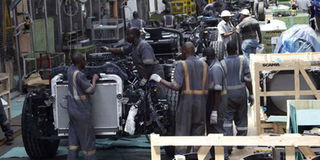Kenya can be a manufacturing nation

Assembling of vehicles takes place at Associated Vehicle Assembly in Jomvu, Mombasa County, on January 24, 2018. PHOTO | LABAN WALLOGA | NATION MEDIA GROUP
What you need to know:
- It would create employment for a million Kenyans by 2022 and boost Kenya’s competitiveness in the international trade arena.
- It calls for our collaborative efforts to turn the tide and demonstrate why the future of Kenya is bright.
The inclusion of manufacturing in the list of priorities in President Uhuru Kenyatta’s ‘Big Four’ agenda is worthy of support by both individuals and the corporate sector.
It would create employment for a million Kenyans by 2022 and boost Kenya’s competitiveness in the international trade arena — both key ingredients for boosting the country’s micro and macro economies.
Unlike many previous policy statements, the government has set very specific, ambitious and time-bound priorities that are much fewer.
This is a very progressive approach, which recognises that what gets measured gets done.
TECHNOLOGY
According to the Kenya Association of Manufacturers (Kam), the sector accounts for 10-11 per cent of the gross domestic product (GDP).
Government statistics however place the contribution at 9.2 per cent with direct employment at just over 300,000 people.
However, the sector’s potential remains volatile and subdued owing to external factors such as drought, which affects energy production in a country that heavily relies on hydroelectric power generation.
This is at a time when manufacturers in more developed countries have embraced artificial intelligence and machine learning, robotics, data and analytics and technology that delivers improved speed and efficiency to boost their overall competitiveness.
AGRICULTURE
At the same time, much of what is manufactured locally is agricultural produce, with tea dominating the list.
Most of the tea is exported to other countries, from where more value addition is done, and then sold for much higher prices with the local farmers removed from the value chain.
The story is all too common across Africa. How do we turn the tide?
On our part as Coca-Cola System in Kenya, together with our bottling partners, we offer direct and indirect employment opportunities to more than 10,000 people through our manufacturing and distribution value chain.
COMMITMENT
Through innovation that goes beyond what exists in Kenya, we are also extending the manufacturing value chain to local farmers, from whom we buy mangoes for juice production.
Our 5by20 global initiative aimed at empowering female entrepreneurs has helped us to train more than 350,000 women from all over Kenya and equip them with the skills and resources to establish or grow their businesses.
This has an impact on household incomes and quality of life.
Having interacted with fellow captains of industry, particularly during the ‘Why the Future is Kenya’ campaign, I know of many other corporate institutions that are playing their part in ensuring that the aspirations on manufacturing in the ‘Big Four’ agenda are achieved.
With every, seemingly, small incentive, they will do even more.
LAW
The labour force in Kenya is unmatched. The people are highly skilled and well-educated and, to crown it, most of them have the right attitude that makes it possible for them to adapt to new technology and trends much faster than their peers in other countries.
The government’s proposals and incentives to encourage local manufacturing include having lower electricity tariffs for night-time usage, improvements in infrastructure and the progressive streamlining of the process of establishing a business.
But there is a need to sustain the positive efforts in having a progressive and conducive legislative and regulatory framework that will support the growth of the manufacturing sector.
The environment should also encourage innovation, often a time-consuming and expensive exercise, so that we will have more products to export and less to import.
COMMUNAL EFFORT
The initiatives designed to boost manufacturing in the cotton, leather, agro-processing, information and communication technology (ICT) and construction are, indeed, realistic and the aspiration to have manufacturing contribute 20 per cent of the GDP, achievable.
The proof point that many people will identify with closely is how many new jobs will have been created by 2022, as this will have a direct impact on their livelihoods.
However, we cannot leave this noble and achievable aspiration to the government alone.
It calls for our collaborative efforts to turn the tide and demonstrate why the future of Kenya is bright, for any sceptic out there to see.
With that, we will attract new investments into Kenya and possibly woo back some manufacturers who had moved their operations to other countries.
Mr Rady, general manager for Coca-Cola, East and Central Africa franchise, is president of the American Chamber of Commerce. Twitter: @Rady197




